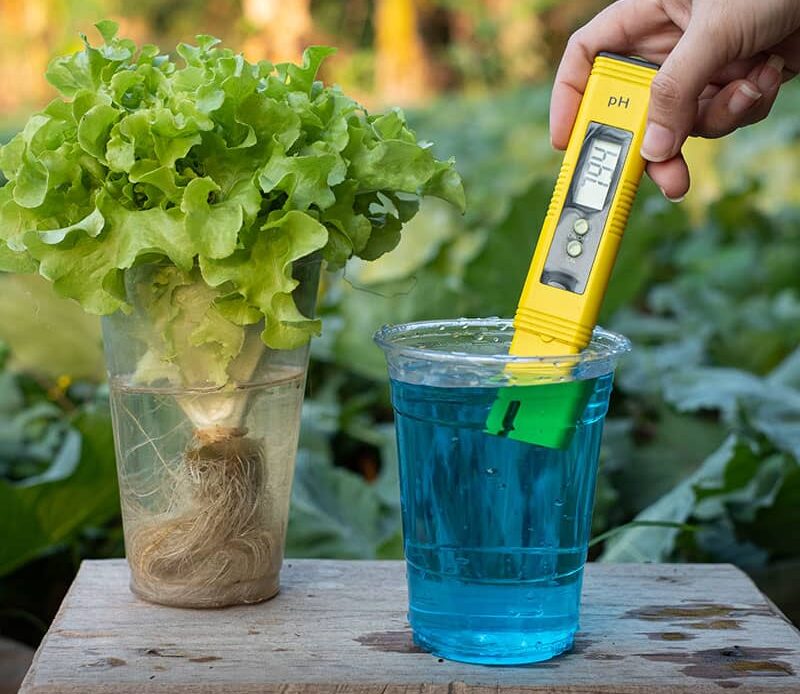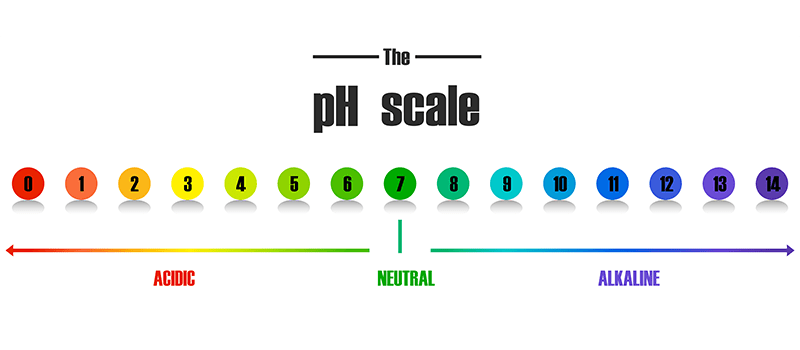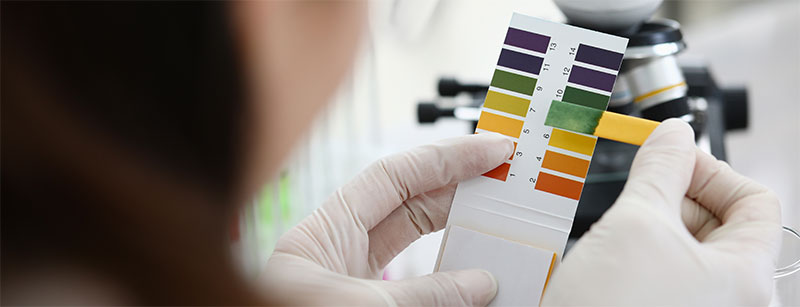
Best pH For Hydroponic play an important role, especially when the necessary nutrients, in the correct amounts, for the plants to grow depend entirely on the gardener actions.
What is pH?
pH is the measure of acidity/alkalinity of a solution. Lower case p is a mathematical function like sin() or cos() are functions. H is the hydrogen ion concentration [H]. The square brackets that are used to designate a concentration are left out.
pH is a way of expressing the concentration of hydrogen ions in a compact way. The letters “pH” come from the Danish chemist Sorensen.
pH = -log[H+] … where [H+] = “concentration of hydrogen ions in moles per liter.”
pH runs from about 0 to about 14. At 25C a neutral solution has a pH of 7. pH values below 7 are acidic, while pH values above 7 are basic.
pH is a measure of the concentration of hydrogen ions in aqueous solution. This is why the pH scale only has meaning for pH between 0–14. Anything outside of this needs other measures of acidity/basicity.
The letters pH stands for POTENTIAL of HYDROGEN.

How Does pH Level Affect Plant Growth?
The plant looses its ability to absorb some of the essential elements required for healthy growth, when the pH is not at the proper level. For any plant to produce optimum results, there is a particular pH level.
For excellent yields and proper growth, the gardener often compare with nutrient and pH chart for hydroponic, to ensure plants are able to absorb and utilize nutrients.
If you grow in too acidic, your plant will most likely die because it can’t absorb nutrients. In the same way, your plant will suffer the same fate, if what you’re growing in is too basic.
How Do You Change the pH?
When using soil you have the advantage of using the soil as a good capacity for buffering pH comparing to hydroponics. With other words if the pH level of the water is not ideal, you can mix the soil in a way that will acts as a buffer and balances out the pH of the incoming water to a level that is generally acceptable.
| Acidic Solutions | pH | Alkaline Solution | pH |
| Battery acid | 1.0 | Blood | 7.35 – 7.45 |
| Gastric acid | 2.0 | Hair shampoo | 8.0 |
| Lemon juice | 2.4 | Sea water | 8.0 |
| Cola | 2.5 | Permanent wave | 8.5 – 9.2 |
| Oxygenated water | 2.5 – 3.0 | Hand soap | 9.0 – 10.0 |
| Vinegar | 3.0 | Hair dye | 9.5 – 10.5 |
| Orange or apple juice | 3.0 | Magic straight | 11.5 |
| Beer | 4.5 | Household ammonia | 11.5 |
| Coffee | 5.0 | Household bleach | 12.3 |
| Milk | 6.6 | Household lye | 13.5 |
| Pure water | 7.0 | Drain cleaner | 14 |
It is very easy to do adjustment to the pH of your nutrient solution. You will need a solution for a pH up and pH down. If you need to raise or lower your pH, then add some pH up or down to your nutrient solution.
The solution pH up is maintaining and raise a nutrient’s pH level. Usually you have to add a little at a time if your nutrient pH is too low in order to raise the pH to the proper level.
pH Down solution helps maintaining and lower a nutrient’s pH level. If your nutrient pH is too high in order to lower the pH to the proper level, you have add a little at a time.
Keeping the pH levels stable, require just a little effort from the gardener and it usually takes a few steps and a few key areas to understand:
- The right supply of water to delivered
- In response to the tested levels, water treatment methods needs to be performed
- Understanding how the addition of nutrients can affect pH levels
- Knowing the pH levels your plants require to grow
What is The Best pH for Hydroponically Grown Plants?
When using hydroponic, setting the right pH levels in your system will help your plants to take up all the micro and macronutrients through the root systems. This make the plants to have an increased intake of NPK (Nitrogen, Phosphorous and Potassium) help your plants to grow faster.
Most plants in soil grow best in a pH 6.5 – 7.0 conditions, while hydroponically-grown plants prefer slightly more acid conditions. For most hydroponic crops, the best pH for hydroponic is between 5.5 and 6.5.
A high pH can reduce the availability of iron, manganese, boron, copper, zinc and phosphorous to plants. A low pH can reduce the availability of potassium, sulphur, calcium, magnesium and phosphorus.
If the pH moves out of the desired range, it can be lowered by the addition of pH Down to the solution, or raised by adding pH Up.
pH can acidify to an unacceptable level when nutrient solutions are used with poor quality water, or pH unstable media, such as rockwool. High growth rates can also destabilize pH.

How Often Should I Check My pH Level?
Hydroponics allows growers to pinpoint pH readings to create optimum conditions and maintain them. This not only leads to healthier, more productive plants but also avoids wasting the valuable nutrient solutions you feed them.
In order to maintain the best pH for hydroponic and tale advantage of the full benefits of growing plans using hydroponic systems you should test your pH every three days or if you notice your plants showing signs of wilting, illness, damage or discoloration.
There are several ways to check the pH of the nutrient solution in a hydroponic system or in soil and compare it to best pH for hydroponic or soil and it is a relatively straight forward process.
Paper Test Strips
We’ll start with the cheapest method uses paper test strips that will change color when dipped in a nutrient solution, because they are covered in a pH-sensitive dye. The next step is to compare the color of the strip to a color chart to help you determine the pH. Unfortunately, this method isn’t very accurate and it can be made more difficult if you have a nutrient solution that isn’t clear and the type of nutrients you’re using may affect the color of your nutrient solution.
pH Test Kit
A liquid based pH test kit is the most popular way to test the pH. pH control is essential for stimulating vigorous plant growth. Fill a test tube halfway with nutrients, add a few drops of pH Test Indicator, and observe the coloration of the liquid in the test vial.
Digital pH Meter
Digital pH Meter is the most accurate method but you have to make sure your device is calibrated and regularly check it. The digital meters are easy-to-use, suitable for the starting hydroponic gardeners as well as serious growers needing to make quick, spot checks of the pH. Most of these meters used in hydroponic growing are relatively affordable and provide dependable read-outs down to a hundredth of a degree on a ten-degree scale.
Using any of these 3 methods you can help you test your pH in order to achieve the best pH for hydroponic.


